Cassville Walking Tour Map
| 1 | The Denniston House (1836) | 15 | River Valley Community Church |
| 2 | Klindt-Geiger Store (1860) | 16 | Old Town Hall |
| 3 | Site of Riverboat Landing | 17 | Old Jail |
| 4 | Riverside Park | 18 | St. Peter's Lutheran Church |
| 5 | Site of Klindt-Geiger Canning Co. | 19 | Furnace Branch Creek |
| 6 | St. Charles Borromeo Catholic Church | 20 | Site of Brick Yard |
| 7 | Reynolds-Redding House | 21 | Joe Barrow's House |
| 8 | Giesen-Brinkman House | 22 | Schreerin-Turtscher House |
| 9 | G. Stevens-Bernhardt House | 23 | R.J. Eckstein House |
| 10 | Kleinpell-Harris House | 24 | BJ's Bar |
| 11 | United Methodist Church | 25 | Main Street |
| 12 | Klindt-Lange House | 26 | Dr. Holford Building |
| 13 | Okey-Ganley Funeral Home | 27 | Sherman Boarding House |
- DENNISTON HOUSE (1836)
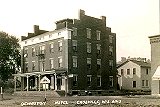 Built by the Daniels-Denniston Company, land speculators from New York, to house legislators and officials should Cassville become the capitol of the new Wisconsin Territory. When Madison was chosen over Cassville to become the capitol, the building and village went into decline until 1855 when former State Governor Nelson Dewey purchased the Denniston interests. He converted the building into a proper hotel.
Built by the Daniels-Denniston Company, land speculators from New York, to house legislators and officials should Cassville become the capitol of the new Wisconsin Territory. When Madison was chosen over Cassville to become the capitol, the building and village went into decline until 1855 when former State Governor Nelson Dewey purchased the Denniston interests. He converted the building into a proper hotel.
It operated as a hotel, dining room and bar until 1985. Today it stands empty. Many additions were added to the "Big Brick" as it was proudly called; but they all have been removed, along with the fifth floor ballroom and widow's walk on the roof. Built of solid brick on a limestone foundation, bricklayers used the sturdy Flemish bond method of laying brick. You can clearly notice its pattern on the side wall. The building still stands proud, though a bit drab, extolling the dreams of a past era.
- KLINDT-GEIGER STORE (c. 1860)
 The site of the Klindt-Geiger Store has been one of commerce since the early 1840's. A wood frame building belonging to Mr. Raffauf dispensed merchandise until it was replaced around 1860 by the present corner two-story brick building. An "L" shaped addition was constructed in 1910 to accommodate the flourishing business. It was the typical "General Store" and served as the social, political, and business center of the village. If you wanted it, they had it, or could get it. If not, you didn't need it anyway. Farmers brought in produce for barter or to sell. Items purchased were stored in a large warehouse that stood in front of the present building, about where the train tracks are today. It held wheat, wool, hides and other products which would ultimately be shipped down river to Dubuque and St. Louis by packet boat. The store continued in operation until 1968 when it closed after 125 years of business, a victim of the automobile and current merchandising methods.
The site of the Klindt-Geiger Store has been one of commerce since the early 1840's. A wood frame building belonging to Mr. Raffauf dispensed merchandise until it was replaced around 1860 by the present corner two-story brick building. An "L" shaped addition was constructed in 1910 to accommodate the flourishing business. It was the typical "General Store" and served as the social, political, and business center of the village. If you wanted it, they had it, or could get it. If not, you didn't need it anyway. Farmers brought in produce for barter or to sell. Items purchased were stored in a large warehouse that stood in front of the present building, about where the train tracks are today. It held wheat, wool, hides and other products which would ultimately be shipped down river to Dubuque and St. Louis by packet boat. The store continued in operation until 1968 when it closed after 125 years of business, a victim of the automobile and current merchandising methods.
- SITE OF RIVERBOAT LANDING
![]() Front and Frederick Streets were the center of commercial activity in the early days. At the foot of Frederick Street, packet and other riverboats unloaded and loaded their goods, took on wood to stoke the steam engines, and continued on their journey. When a boat landed there was always a great flurry of activity which provided the local residents contact with other cities and villages along the river.
Front and Frederick Streets were the center of commercial activity in the early days. At the foot of Frederick Street, packet and other riverboats unloaded and loaded their goods, took on wood to stoke the steam engines, and continued on their journey. When a boat landed there was always a great flurry of activity which provided the local residents contact with other cities and villages along the river.
- RIVERSIDE PARK
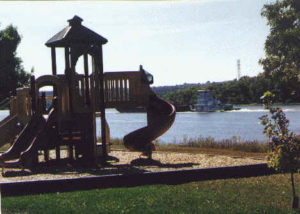 It has been the village park since the 1890's and contains an eagle effigy mound constructed by the same Indian culture which built the mounds located in Nelson Dewey State Park. Prehistoric peoples from around 1000 B.C. are credited with their construction.
It has been the village park since the 1890's and contains an eagle effigy mound constructed by the same Indian culture which built the mounds located in Nelson Dewey State Park. Prehistoric peoples from around 1000 B.C. are credited with their construction.
- SITE OF KLINDT-GEIGER CANNING CO. (1893-1950)
 Incorporated in 1893, pickles and sauerkraut were the canning company's main product. Thus it was always known locally as "The Pickle Factory". Tomatoes, peas and corn were added later, bearing brand names like "Dependon", "Riverview", "Badger" and "Dewey". The company became one of the first producers of creamed corn in the country and provided the largest source of employment in the area in its time. Frozen foods and other problems sounded the end, and today only the large brick warehouse is left standing, now part of the Rapid Die and Molding manufacturing complex.
Incorporated in 1893, pickles and sauerkraut were the canning company's main product. Thus it was always known locally as "The Pickle Factory". Tomatoes, peas and corn were added later, bearing brand names like "Dependon", "Riverview", "Badger" and "Dewey". The company became one of the first producers of creamed corn in the country and provided the largest source of employment in the area in its time. Frozen foods and other problems sounded the end, and today only the large brick warehouse is left standing, now part of the Rapid Die and Molding manufacturing complex.
- ST. CHARLES BORROMEO CATHOLIC CHURCH (1889)
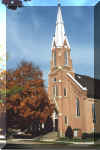 The present Victorian Gothic church replaces an earlier plainer church built in 1857. Ex-governor Dewey donated six lots at a token price of $5.00 thereby providing the site for a church. Constructed of solid brick upon a limestone foundation, its steeple soars 137 feet in the air and is topped with a golden cross. The interior retains most of the original splendor of its German Gothic decor and should be seen. If the door is open, please come in.
The present Victorian Gothic church replaces an earlier plainer church built in 1857. Ex-governor Dewey donated six lots at a token price of $5.00 thereby providing the site for a church. Constructed of solid brick upon a limestone foundation, its steeple soars 137 feet in the air and is topped with a golden cross. The interior retains most of the original splendor of its German Gothic decor and should be seen. If the door is open, please come in.
- REYNOLDS - REDING HOUSE (c. 1891) 417 E. DEWEY
Built by Mrs. Carrie Reynolds, this is the finest and only example of a mansard roofed cottage in the area. Because of personal problems the house stood empty from completion until 1893 when Mrs. Reynolds sold the property. A succession of owners added to the original brick core two frame rooms, but left the integrity of the mansard roof intact.
- GIESEN - BRINKMANN HOUSE (c. 1900) 409 E. DEWEY
This brick cottage with a 1935 Salt box addition is typical architecture of the era and conveys a warm, cozy appearance.
- G. STEVENS - BERNHARDT HOUSE (c. 1900 - 1910) 306 E. DEWEY
Built for the locally prosperous banker Gustav Stevens in the early 1900's, it retains most of the original Queen Anne architectural touches. The wraparound porch was removed and a side porch was enclosed; otherwise, all is original. The interior still contains its beautiful oak trim and ornate oak columns. A local architect and carpenter Frank Eckstein is credited with this fine residence as well as many others in the village. He is the great-grandfather of the present owner.
- KLEINPELL - HARRIS HOUSE (c. 1892) 213 E. DEWEY
Eugene Kleinpell, a harness shop proprietor, was the original owner of this residence. Two Kleinpell sisters retained possession of the home and upon their death it was sold at auction. After several years of standing unoccupied, the Harris family purchased the house and restored it to today's state. A new frame addition has recently been added to the rear of the brick home.
- UNITED METHODIST CHURCH (1891)
The United Methodist Church is a gem of early ecclesiastical construction. The drip caps over the Gothic windows are in harmony with the diamond window on the front and steeple. The exterior is original in all its details. However, the interior has been renovated many times, the latest being in 1989.
- KLINDT-LANGE HOUSE (1888) 401 FREDERICK
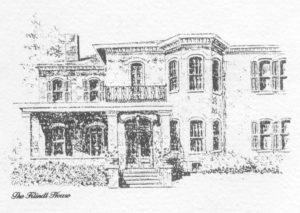 John Klindt, senior partner in the Klindt-Geiger enterprises, chose this site for the building of his large home. Brick walls 16" thick rest on a limestone foundation and support a steeply pitched roof. The architectural style is eclectic combining Italianate and Queen Anne features. The original roof of slate with cast iron cresting was removed in 1962. A small wooden porch was replaced with the present in 1923. However, the shutters and other features date from 1888.
John Klindt, senior partner in the Klindt-Geiger enterprises, chose this site for the building of his large home. Brick walls 16" thick rest on a limestone foundation and support a steeply pitched roof. The architectural style is eclectic combining Italianate and Queen Anne features. The original roof of slate with cast iron cresting was removed in 1962. A small wooden porch was replaced with the present in 1923. However, the shutters and other features date from 1888.
- OKEY-GANLEY FUNERAL HOME (c. 1860) 313 FREDERICK
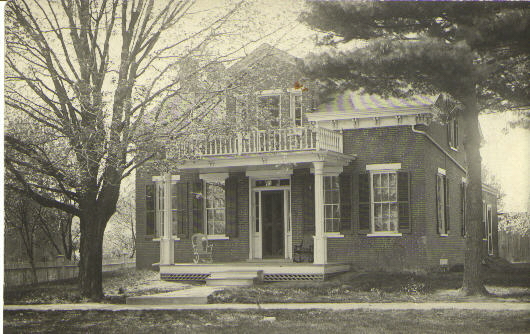 Louis M. Okey affectionately known as "Pa Okey" built this excellent example of Greek Revival. Note the pediment in front formed by a gable roof and eave returns. The second floor balcony door has window lights on each side and a transom above. The frame addition is a later improvement, but the original Greek Revival design shines through.
Louis M. Okey affectionately known as "Pa Okey" built this excellent example of Greek Revival. Note the pediment in front formed by a gable roof and eave returns. The second floor balcony door has window lights on each side and a transom above. The frame addition is a later improvement, but the original Greek Revival design shines through.
- JOHN GEIGER HOUSE (1855) 401 DENNISTON
 John Geiger, proprietor of the Geiger Store, which later became Klindt-Geiger Co. had this Greek Revival home constructed in 1855. Designer-builder, John Snechlode (uncle ofJohn Klindt), using a style popular throughout the country at that time, is credited with construction. Note the original six over six windows (many with their original glass), original entry door with side lights and transom,and end gables with eave returns suggesting a Greek pediment. Truly one of our local gems. The exterior is mostly original and retains its detailing. The house remained in the Geiger family for 114 years until 1969 and is now operated as a bed and breakfast.
John Geiger, proprietor of the Geiger Store, which later became Klindt-Geiger Co. had this Greek Revival home constructed in 1855. Designer-builder, John Snechlode (uncle ofJohn Klindt), using a style popular throughout the country at that time, is credited with construction. Note the original six over six windows (many with their original glass), original entry door with side lights and transom,and end gables with eave returns suggesting a Greek pediment. Truly one of our local gems. The exterior is mostly original and retains its detailing. The house remained in the Geiger family for 114 years until 1969 and is now operated as a bed and breakfast.
- RIVER VALLEY COMMUNITY CHURCH (1880) 402 DENNISTON
A Baptist Church until recent years, it was dedicated October 3, 1880 and has changed little since. The only significant remodeling was a slight modification to the steeple in the1930's. The bell it contains was purchased for $128 in 1885, brought to Cassville over the frozen Mississippi from Iowa, and installed in the steeple. An inside door came from Governor Dewey's mansion, saved from the fire that destroyed his home. A small dugout portionunder the church contains a furnace that provides heat.
- OLD TOWN HALL (1889)
This building served for many years as town hall, library and jail. The second floor was a large open room used for church bazaars, dances, and other social functions while the basement contained the calaboose. The Village Board and Fire Department used the building for their meeting rooms but later vacated to newer and larger quarters. On the site of the present day garage (behind the building) stood the 1892 fire engine house and tower which contained an alarm bell. A back porch has been added, the first and second floors are converted into apartments. The Town Hall with fire station and jail can be seen in the lower left of this photo of Cassville.
- OLD JAIL (c. 1900)
The jail was built to house vagrants, town pranksters, tramps and others needing incarceration. Constructed of brick, one can still see the iron bars at the windows and heavy metal door. Today's use, storage.
- ST. PETER'S LUTHERAN CHURCH (1892) W. Bluff
The German Lutheran Church was erected bythe congregation in 1892 on a lot donated by John Klindt. Originally constructed as a wood frame church with gothic touches, brick veneer was added in later years. Lightning struck the steeple in 1976 causing a fire which did extensive damage. The fire was confined to the steeple area, thereby saving the church proper. Today's steeple is a replica of the original.
- FURNACE BRANCH CREEK HOLLOW SITE OF THE CASSVILLE BREWERY ( 1854)
Furnace Branch Creek Hollow, so named because of the lead smelting operation it once contained, also was the site of the Cassville Brewery. For many years Cassville boasted of its fine bottled beer and produced numerous cases for sale throughout the area. The trade name "Old Fashioned Lager" was prized in its time. However, today it's the labels and bottles that are hunted for and prized by collectors. The brewery ceased operation in 1938 and the buildings were later demolished.
- SITE OF BRICK YARD (c. 1867)
Joe Barrows owned and operated a brick yard on this site. The clay pit was about where the swimming pool is located with the kiln nearby. The clay produced a salmon color brick, but it was very soft. Once the hard outer surface is penetrated the core becomes almost powder. Little sandblasting has ever been done in this town! You will notice that all older brick buildings were built with Barrows bricks and they have now mellowed to a warm terra cotta in color.
- JOE BARROW'S HOUSE ( c. 1870) 217 WIOTA
Owner of the brick yard, this house is built of "Barrow's bricks" and remains mostly original. The modern touches can easily be recognized.
- SCHREERIN - TURTSCHER HOUSE (c. 1900) 309 W. DEWEY
Constructed by carpenter-owner Rudolf Schreerin, this house is an excellent example of Eastlake ornamentation, a style popular in the 1880's. It was added to houses to modernize them and bring them " up-to-date". How fortunate we are to have this distinctive porch left intact.
- R. J. ECKSTEIN HOUSE (1926) 206 W. DEWEY
Built by R. J. and Myra Eckstein, this Tudor Revival is an outstanding example of a style popular in the early part of the 20th century. All features are original and is meticulously maintained. Attractive landscaping helps to complete the setting.
- BJ'S BAR (1891) 301 DENNISTON
Most every community had a corner saloon such as this one. Living quarters above with a bay window over the front door, interesting window drip caps, and swags along the cornice being so "typical", it served as the model for Stonefield's saloon.
- MAIN STREET (c. 1880's - 1914)
Three blocks comprise the business section of the village. Store fronts have changed through the years, so to enjoy the architecture one has to look up and notice cornice and window treatments. Most would come under the Italianate style, with some Victorian bracketing. Do you recognize which ones are constructed of Barrow's bricks? Pick out your favorite building and then tell the proprietor of your choice.
- DR. HOLFORD BUILDING (c. 1890) 301 AMELIA
Built of Barrow's bricks, the first floor contained the doctor's waiting room on one side and examining room on the other. The second floor was family living quarters. Note the double bay windows, shutters, second floor porch, and the abundance of "gingerbread". Truly a gem!!
- SHERMAN BOARDING HOUSE (c. 1856) 117 W. FRONT STREET
Constructed around 1856 by James L. Sherman, an engineer on the snag puller General Barnard, the home contained his living quarters and rooms for boarders. Locally known as "The Sherman House" it boasted a one story porch across the front, quantities of gingerbread adorning the dormers, porch and roof, shuttered windows and a cupola crowning the roof. Through the years most of these elements have been restored. The Greek Revival entrance with its sidelights and transom is sheltered from the elements by the porch. One should note the coffin door, as it is called in some areas, above the entrance. Its purpose can be determined from its name. Today the many rooms located on the second floor make for a bed and breakfast, its use today.
This concludes your tour, which presents a generalview of ourvillage, and we hope it was informative aswell asentertaining. We realize homes and buildings of equalarchitectural or historic significance may have been omitted and we leave them for you to seek out. Governor NelsonDewey, who was mentioned many timesin this tour hashis plantation and home located 2 milesout of town. Now operated as a state historic site by thestate of Wisconsin, it is open to thepublic -- Memorial Dayto early October.
This information has been compiled by the Cassville Historical Society .

